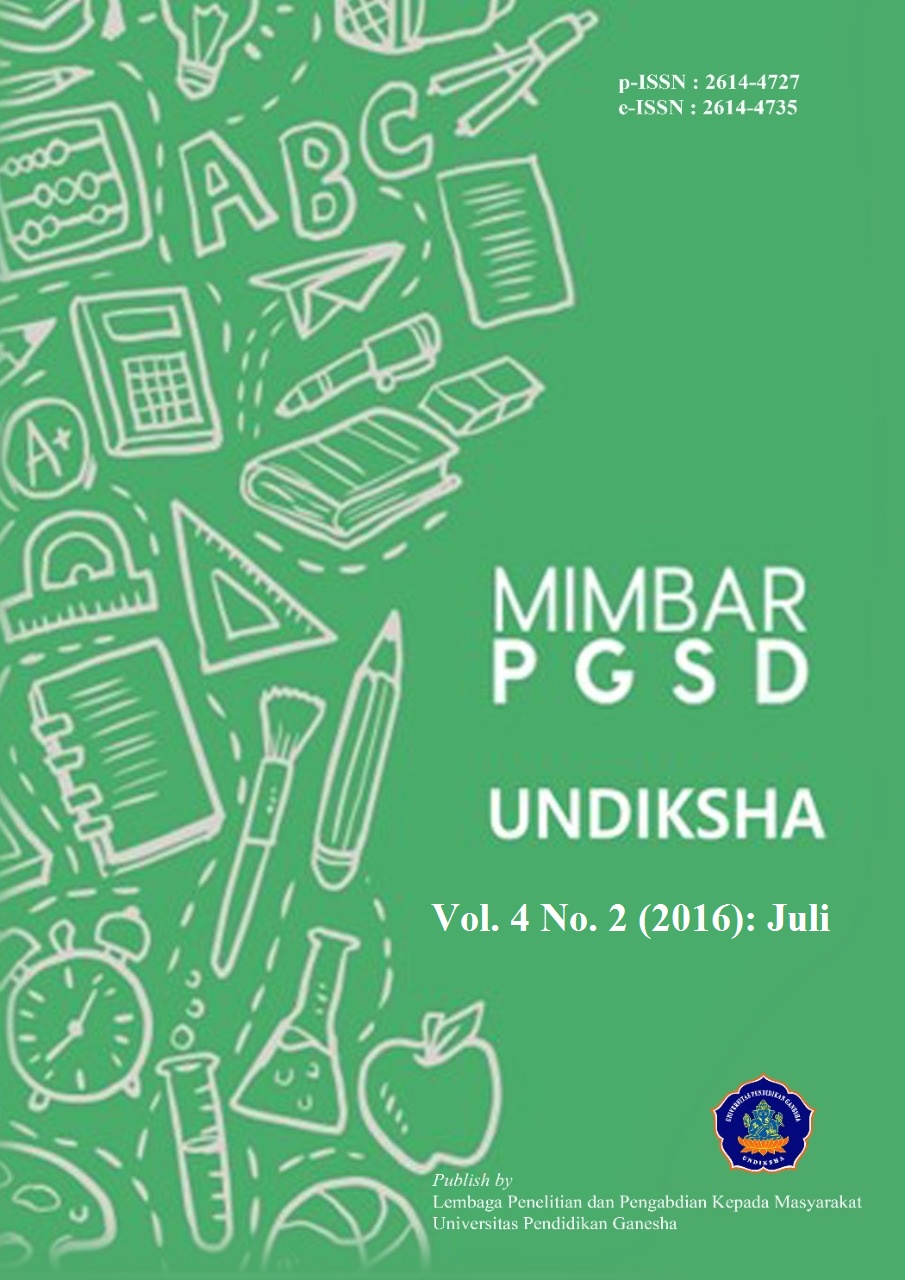PENERAPAN MODEL PEMBELAJARAN KOOPERATIF TIPE NUMBERED HEAD TOGETHER (NHT) UNTUK MENINGKATKAN HASIL BELAJAR IPA SISWA KELAS IV SEMESTER I SD NO 5 SELAT KECAMATAN SUKASADA KABUPATEN BULELENG TAHUN PELAJARAN 2015/2016
DOI:
https://doi.org/10.23887/jjpgsd.v4i2.7622Abstract
Penelitian ini bertujuan untuk mengetahui peningkatan hasil belajar IPA setelah menerapkan model pembelajaran kooperatif tipe numbered head together (NHT) pada siswa kelas IV SD No 5 Selat, Kecamatan Sukasada, Kabupaten Buleleng, Tahun Pelajaran 2015/2016. Jenis Penelitian ini adalah penelitian tindakan kelas yang dilaksanakan dalam dua siklus terdiri atas tahap perencanaan, tahap pelaksanaan tindakan, tahap observasi/evaluasi, tahap refleksi. Subjek penelitian adalah siswa kelas IV semester I Tahun pelajaran 2015/2016, yang berjumlah 20 orang. Objek penelitian adalah Hasil belajar IPA dan Penerapan Model NHT. Metode pengumpulan data yang digunakan adalah tes isian. Data dalam penelitian ini dianalisis dengan analisis deskriptif kuantitatif. Hasil penelitian menunjukkan bahwa dengan Penerapan Model pembelajaran NHT dapat meningkatkan hasil belajar IPA pada siswa kelas IV semester I SD No 5 Selat Kecamatan Sukasada, Kabupaten Buleleng. Hasil belajar pada siklus I menunjukkan 66,75% dengan tingkat hasil belajar berada pada kategori sedang. Kemudian pada siklus II rata-rata nilai hasil belajar siswa meningkat menjadi 88,25% dengan tingkat hasil belajar berada pada kategori tinggi. Berdasarkan hasil penelitian tersebut dapat disimpulkan bahwa penerapan model pembelajaran NHT dapat meningkatkan hasil belajar IPA pada siswa kelas IV semester I SD No 5 Selat Kecamatan Sukasada, Kabupaten Buleleng Tahun Pelajaran 2015/2016. Disarankan kepada seluruh guru sekolah dasar agar menerapkan Model pembelajaran Tipe Numbered Head Together (NHT) dalam pembelajaran IPA.Kata Kunci : Pendekatan Model kooperatif tipe NHT, Hasil belajar IPA
This study aims to determine the learning outcome IPA after applying cooperative learning model Numbered Head Together (NHT) in the fourth grade students of SD No. 5 Strait, District Sukasada, Buleleng, in the academic year 2015/2016. This type of study is classroom action research conducted in two cycles consisting of the planning phase, the implementation phase of action, observation / evaluation, reflection stage. Subjects were students in the fourth grade the first semester of school year 2015/2016, totaling 20 people. The object of research is to learn science and Implementation Results NHT Model. Data collection method used is the field test. The data were analyzed by quantitative descriptive analysis. The results show that with the adoption of NHT learning model can improve learning outcomes IPA in the first half of the fourth grade students SD No. 5 Strait Sukasada subdistrict, Buleleng. Results of study on the first cycle showed 66.75% to the level of learning outcomes in middle category. Then in the second cycle the average value of student learning outcomes increased to 88.25% with the level of learning outcomes at the high category. Based on these results it can be concluded that the application of NHT learning model can improve learning outcomes IPA in the first half of the fourth grade students SD No. 5 Strait Sukasada subdistrict, Buleleng regency in the academic year 2015/2016. It is suggested to all primary school teachers in order to implement the type of learning model Numbered Head Together (NHT) in science teaching.
keyword : NHT type cooperative model approach, learning outcomes IPA
Published
2016-07-19
How to Cite
., P. M. D., ., D. G. N. J., & ., U. (2016). PENERAPAN MODEL PEMBELAJARAN KOOPERATIF TIPE NUMBERED HEAD TOGETHER (NHT) UNTUK MENINGKATKAN HASIL BELAJAR IPA SISWA KELAS IV SEMESTER I SD NO 5 SELAT KECAMATAN SUKASADA KABUPATEN BULELENG TAHUN PELAJARAN 2015/2016 . MIMBAR PGSD Undiksha, 4(2). https://doi.org/10.23887/jjpgsd.v4i2.7622
Issue
Section
Articles
License
Authors who publish with the Mimbar PGSD Undiksha agree to the following terms:
- Authors retain copyright and grant the journal the right of first publication with the work simultaneously licensed under a Creative Commons Attribution License (CC BY-SA 4.0) that allows others to share the work with an acknowledgment of the work's authorship and initial publication in this journal.
- Authors are able to enter into separate, additional contractual arrangements for the non-exclusive distribution of the journal's published version of the work (e.g., post it to an institutional repository or publish it in a book), with an acknowledgment of its initial publication in this journal.
- Authors are permitted and encouraged to post their work online (e.g., in institutional repositories or on their website) prior to and during the submission process, as it can lead to productive exchanges, as well as earlier and greater citation of published work. (See The Effect of Open Access)















